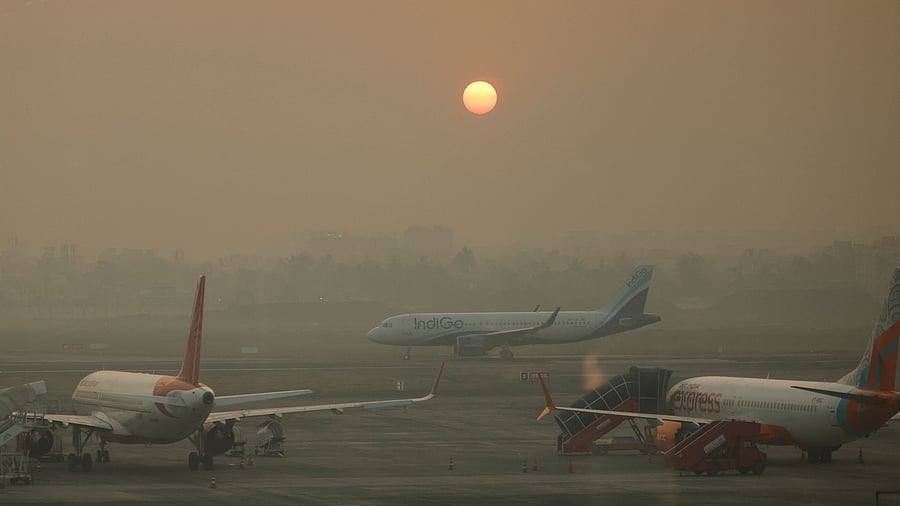
An IndiGo Airlines aircraft taxis on the tarmac on an early morning at the Netaji Subhash Chandra Bose International Airport, in Kolkata, India, November 20, 2024.
Credit: Reuters Photo
Indian airlines are slowly but surely expanding their wings to take a larger share of non-stop international flights. Earlier this month, IndiGo, which has a domestic market share of over 60 per cent, announced that it had become the largest foreign operator out of Sri Lanka operating 54 weekly frequencies from Jaffna and Colombo to four points in India.
Indian airlines’ share on the India-Sri Lanka route will go up further as Air India operates 21 weekly services and Alliance Air operates three weekly services to Sri Lanka.
The latest development on the India-Sri Lanka air route is a reversal of history. In October 2003, Prime Minister Atal Bihari Vajpayee and Sri Lankan Prime Minister Ranil Wickremesinghe had signed an open sky agreement which allowed Sri Lankan airlines to fly daily into India’s metro cities and unlimited frequencies into 18 tourist destinations.
Sri Lankan airline, which was under Emirates airline’s management control, was able to quickly secure more aircraft and become the largest foreign carrier out of India with over 100 weekly services. But with Sri Lankan reverting to government control, the number of weekly flights has come down and IndiGo has now taken this spot.
The United Kingdom is another country where Indian airlines dominate the skies. Data by OAG for this month shows that Air India is operating 284 flights while British Airways is operating 240 flights and Virgin Atlantic 154 flights between India and the UK. OAG provides data for the global travel industry and has the world’s largest network of flight information. On the India-UK route, the balance is going to tilt further in India’s favour as news reports have appeared that IndiGo is set to launch daily services between India and UK sometime later this year.
Both are significant developments – the UK is one of the biggest markets for domestic and international airlines given the large number of Indians who live and work in that country. Closer home, India and Sri Lanka enjoy close people-to-people relations and India was the largest tourist market for Sri Lanka with close to 600,000 Indians visiting the island nation.
Late last year, the Directorate General of Civil Aviation (DGCA) allowed Indian airlines to wet lease aircraft. There are two kinds of leases – a dry lease in which the airlines from India take the aircraft and use their own crew to operate the flights. In comparison, in a wet lease, the crew, aircraft insurance and maintenance is provided by the company from which the aircraft is leased.
DGCA’s decision was taken keeping in mind the supply chain disruptions Airbus and Boeing are facing. Air India has ordered 570 aircraft, IndiGo has ordered 530 aircraft and has rights to order another 70 wide-body A 350-1000 aircraft while Akasa has ordered 150. Till those aircraft come in, with a wet lease Indian airlines will be able to quickly deploy aircraft on domestic and international routes while waiting for the delivery of their own aircraft.
Besides, the current government has been very selective in exchange of air services bilaterals or treaties that are exchanged between two countries which allow airlines from the two countries to designate carriers to operate between them. Like in the case of India and the UK, it was decided to increase the weekly flight services airlines from both sides can operate to 70.
The shift is here
Among them, Indian carriers have ordered over 1,300 aircraft including wide-body aircraft capable of flying non-stop between India and the United States and Canada which are two key source markets for Indian airlines. What will further help Indian carriers is that India has an open skies policy with both US and Canada under which airlines from both sides can launch as many flights as they like.
For decades, foreign airlines have been carrying a larger share of traffic from India than that carried by Indian airlines because of two reasons. Air India was under government control and ordering new aircraft was a slow and tedious process.
In addition, private airlines did not have the fleet strength and wide-body aircraft to take on the likes of Etihad, Qatar Airways, Emirates as well as the European and South East Asian carriers. About two years back, it was estimated that foreign airlines carried 70% or more of passengers travelling abroad from India. This situation does not exist anywhere in the world.
Now, with Indian airlines coming into their own, setting a global record for ordering aircraft in a calendar year and the developments that have been seen in the India-UK and India-Sri Lanka markets, it is a matter of time before Indian airlines carry more passengers abroad and correct a wrong that has gone uncorrected for decades.
(The writer is a Delhi- based senior aviation journalist)